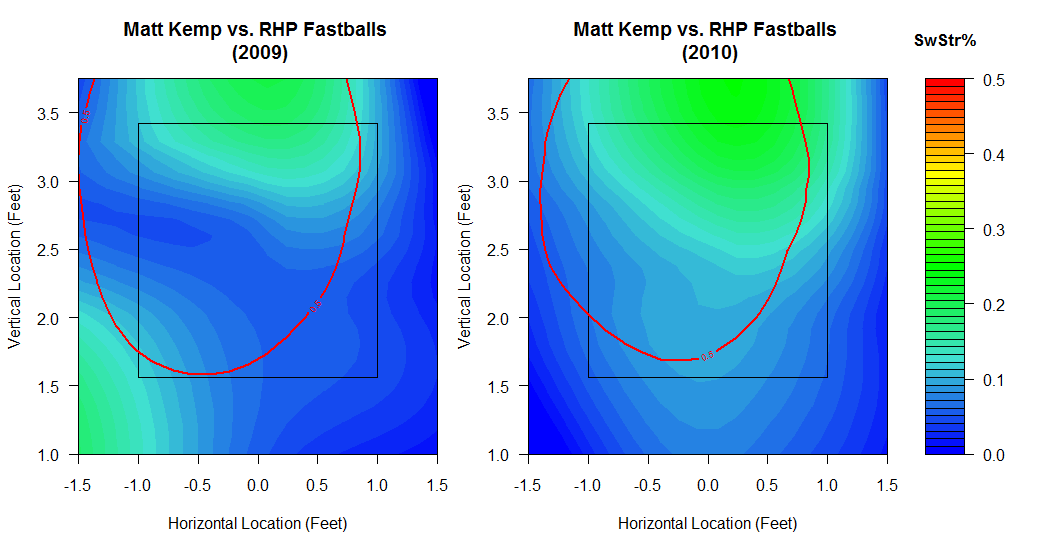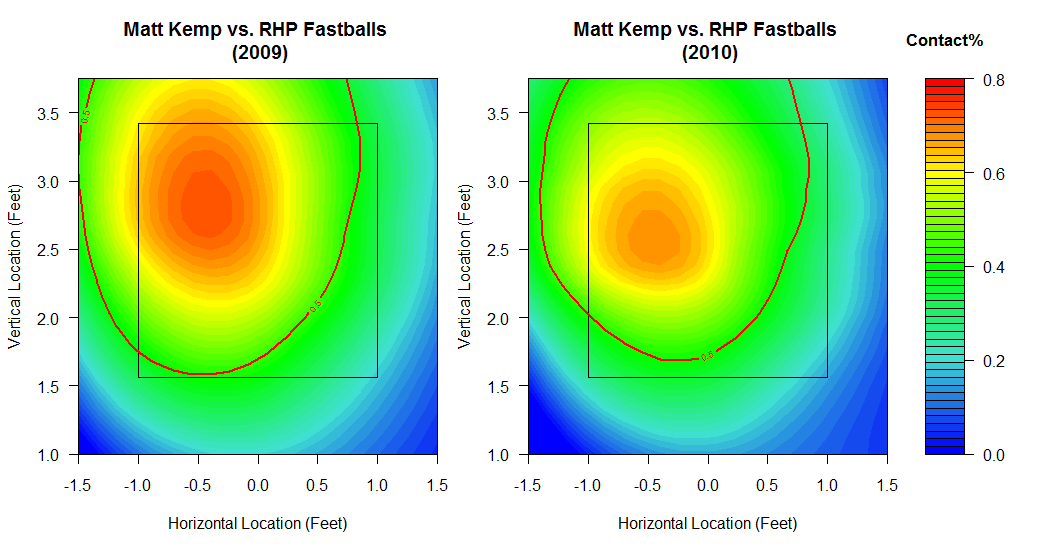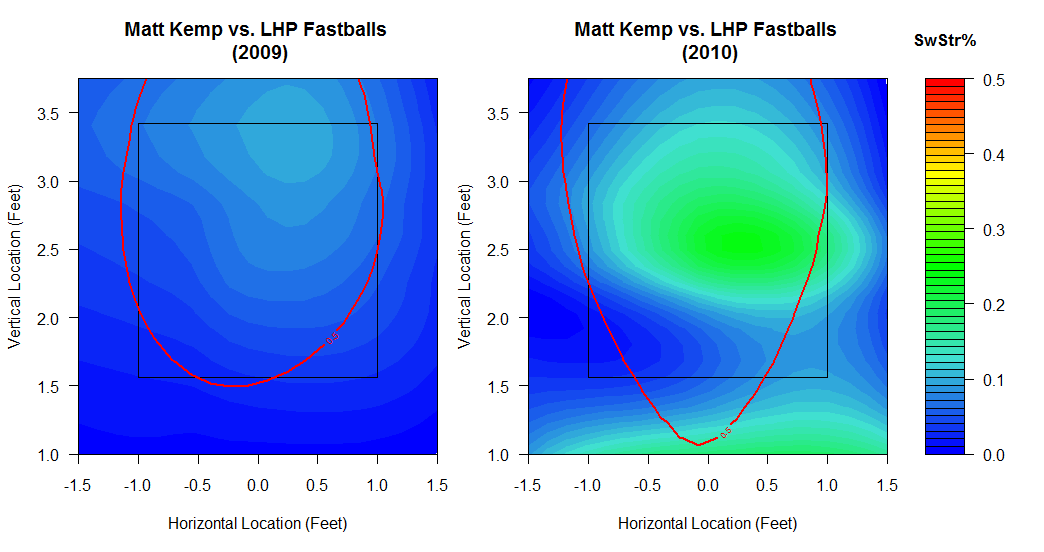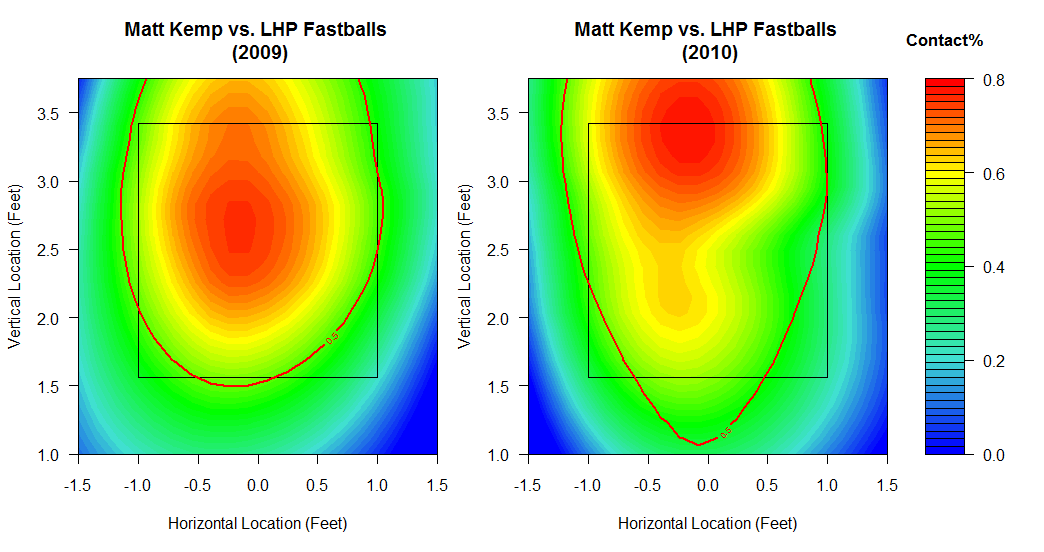A few weeks ago, Sportvision hosted the 3rd Annual Pitchf/x Summit. Sportvision is the company behind the Pitchf/x system and has initiated Fieldf/x, which I’ll get into in a minute. The goal of the summit was to share some of the research being done in baseball analysis, while also serving to explain the possibilities that exist with the new system. Without further ado, here were the presentations:
Using Velocity Components to Evaluate Pitch Effectiveness (Matt Lentzner/Mike Fast): The purpose of this study was to change the reference point by which Pitchf/x data are measured. Often, fastballs show more movement than breaking balls, but without the proper frame of reference, it means nothing. Mike and Matt were able to demonstrate how to determine the horizontal and vertical velocities with respect to the batter’s eye and make the Pitchf/x data more meaningful.
Pitchf/x Application in Player Development and Evaluation (Dr. Glenn “Butch” Schoenhals): Dr. Schoenhals has a Pitchf/x system set up at his instructional school, which allows pupils (including some major leaguers) to see the their pitches broken down immediately and make adjustments. In conjunction with three cameras set up around the pitcher, the Pitchf/x data provide benefit to both pitchers and instructors in learning/teaching how to pitch.
Okajima’s Mystery Pitch (Matt Lentzner): Hideki Okajima throws a pitch roughly 20% of the time that had previously been classified as a curveball, more specifically a “rainbow curveball.” Actually, it didn’t really fit any of the known pitch types. Using his research on pitch types and arm slots (“The Pitching Peanut”), we see that this pitch has almost no break, is faster than a curveball but slower than a slider, and falls at the exact center of the peanut. His explanation: Okajima is the Boston pitcher who is actually throwing the gyroball, not his more famous teammate Daisuke Matsuzaka.
Leaving the No-Spin Zone (Alan Nathan): Dr. Nathan showed his experiments that relate the spin of the baseball just before and just after it is hit. The result? The two are almost totally independent of each other! I couldn’t believe that, but Dr. Nathan made a lot of sense. This was a high-grade physics lesson, crashed into about 20 minutes. He explained why balls tend to curve toward the foul lines; he showed that the bat actually “grips” the ball for a few nanoseconds or so before the ball explodes off the bat, which contrasts the earlier model of the ball “rolling” off the bat. Really, really cool.
Fieldf/x System Overview (Vidya Elangovan): And the main event began. Fieldf/x is a new tracking system that utilizes cameras attached to the light standards in baseball stadiums (for now, just AT&T Park) to track the movement of every person on the field 15 TIMES A SECOND. As soon as I heard that, my mind started going crazy and I don’t think I paid attention for about 5 minutes. The only issue at the time is that the system does not include the ball (but it will). All ball events currently have to be added by someone watching the video. The following presentations showed some of the things you can actually do with the data, and it’s fairly obvious that these data, particularly when connected to batted ball data through the Hitf/x database, are about to revolutionize how baseball players are evaluated.
Infield Defense with Fieldf/x (John Walsh): Actually the first presentation, thanks to being in Italy, (tough life), but it really would have been more helpful after the overview. Either way, a lot of cool stuff. First thing he said was that in tracking the different players, he noticed that an average centerfielder runs 8 miles per game, which stunned me and kept my attention. Thanks to these new data, we can also see the effects of shifts and also what players away from the ball are doing while teammates are attempting to make plays. Other questions John poses: can we see infielders cheating in a certain direction as the pitchers throws the ball? Do infielders lean in a certain direction before the pitch? Based on his initial investigations, he saw that third basemen step toward the line as the pitch is delivered and shortstops step directly at home plate. Weird, but potentially important, and just a peak into what can be obtained.
From Raw Data to Analytical Database (Peter Jensen): As a baseball nerd and a programming dork, this was really cool. Peter Jensen took the 400,000 lines of code that results from each game and wrote a macro to display what actually happened in the game in an Excel worksheet. The simulation relates the position of each player as well as an approximation of where the ball is throughout the play. His solution with regards to the reorganization of the data was very impressive for a first run, and it is absolutely vital to make the data useful for analysis.
Using Fieldf/x to Assess Fielders’ Routes to Fly Balls (Dave Allen): These next three were absolutely incredible to me (and I’m sure the last three would have joined them had I had the time to stay). By using the data to reconstruct fielders’ routes to the ball, Allen surmises that the Fieldf/x data can be used to determine the speed of an outfielder as they pursue a ball, the starting points of each fielder at the time of the pitch (and hit), and how efficient each player is in getting to the ball (measuring the distance traveled against the shortest distance to the ball). To me, this is something that teams can use to help players they already have by addressing alignment issues or noticing what is happening during the different points of pursuit. Are outfielders getting good reads/jumps on the ball? Are they running in straight lines or weaving? Simply put, the data can confirm for us (and also measure exactly and more efficiently) what our eyes (and scouts’ eyes) have seen.
Measuring Base Running with Fieldf/x (Mike Fast): Mike’s presentation examined the different portions of base running and what the data can be used for. Mike was able to track each base runner’s path around the bases, even what they were doing on pitches that weren’t hit (during which we would typically say “nothing happened”). Obviously, with all of these data, there’s a lot happening. Also, by knowing the position of the player at each moment in time, we can track both his speed and acceleration as rounds the bases; very valuable information for measuring “baseball speed.”
Fieldf/x of Probabilities: Converting Time and Distance into Outs (Jeremy Greenhouse): The coolest of the presentations. As soon as he said the words “probability model,” I was sold. Jeremy first examined stolen base attempts (in the thirteen games of data released, he only found four) and tried to determine the different component times of the stolen base attempt. Some things he brought up that were interesting: “Pop” times, or the time it takes a catcher to catch the ball and get it to second base, was between 2.0 and 2.2 seconds for all attempts, which suggests that a lot of stolen bases are taken off pitchers, not catchers. The ability to get a good lead is now measurable, as well as the jump a runner gets on the pitcher.
Jeremy also developed a model to determine the probability that a player makes a play on a ball hit near him. The model was based on where the player is, where the ball would come down, and how long it would take the ball to get there. From there, the player’s probability can change based on his jump, route, speed, and what I called “catching ability,” or the ability to actually make a play on the ball when in the vicinity. It was shocking to see some of the plays made where players started out with low (less than 10 percent) chances of catching the ball, but by getting a good jump and running (quickly) in a straight line toward the ball, their probability would increase each 1/15 of a second. He then showed the video of these plays and we were able to see the spectacular catches made by really good outfielders. This also applies to outfielders who start with a low probability to make the catch, but increase it as they, for example, chase a ball into the gap, close quickly on it, but don’t catch it. The ability to increase the probability of a catch is very valuable and that knowledge would be immensely valuable to teams. Lastly, he also showed how bad outfielders can turn outs into hits by reading the ball poorly, getting bad jumps, and being indecisive. Super cool, and as soon as the presentations are made available online (which hopefully will be soon), I will link to some of them, but especially some of these graphs.
Unfortunately, I missed the following presentations, so I will just show the abstracts presented in the program.
Where Fielders Field: Spatial and Time Considerations (Matt Thomas): Continued application of close-range photogrammetry through high-resolution digital photography to baseball is revealing hitherto unseen patterns of fielding in the game. Matt examines these patterns and where data permit, factors time into this examination. After reviewing general trends he notes specific achievements and then speculates on whether any of this freshly quantified insight tells us what makes for good (and not so good) fielding.
Scoutf/x (Max Marchi): This presentation evaluates players’ tools with Pitchf/x, Hitf/x, and Fieldf/x.
True Defensive Range (TDR): Getting out of the Zone (Greg Rybarczyk): Greg intends to display detailed tracking of the 25 batted balls in the released data that were hit in the air to the outfield. Presented data will include the relative positions of the outfielders and the ball from the time the ball leaves the bat until the time it is retrieved by the fielder. Using the essential elements of this data (fielder starting position, ball hang time and landing point), he outlines the fundamentals of a new outfield defensive metric, called ‘True Defensive Range’ or TDR, which should provide more accurate player defensive ratings with a smaller required sample size than current metrics. Full realization of this metric will require establishment of baseline values using the full data set. TDR for infielders will employ a similar method, but it will not be covered during this presentation.
The Future of Sportvision’s Data Collection (Greg Moore): Greg will talk about several bits of baseball data that Sportvision might collect in the future, and he will discuss how the data can be used in conjunction with Pitchf/x, Hitf/x, and Fieldf/x. Greg will also conclude the 2010 Pitchf/x Summit with closing remarks.
Obviously, there was a lot of cool stuff presented. As mentioned, only 13 games worth of data were released to the analysts and most of the presentations were about determining what could be done with the data. But with enough work and research, it will not only change the way teams and analysts evaluate players, but also will give teams another tool with which to teach their players and improve the guys they already have on the roster. We’ll also know exactly what skills are important in each aspect of the game (base running, fielding, etc.), and as we learn these things we’ll discover other things we want to know. I’d love to know what you guys think of all this and I’ll try to answer any questions you have about what can and can’t be measured and how we’ll use it in the future.
UPDATE: After I wrote this mess, I discovered this, much cleaner, detailed, mess, written by Baseball Prospectus writer Ben Lindbergh. I’ll link to it down here because I want you to read what I wrote instead of Ben’s running diary. Sorry, Ben.
This article was originally published at Knuckleballs, written by Dan Hennessey.




